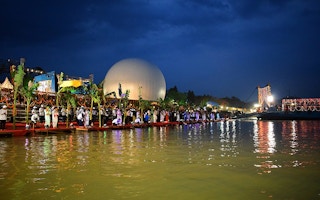A warmer world may not be just a wetter one. It may get even warmer as well. New studies suggest the heavier rain that will accompany ever-higher global average atmospheric temperatures is in itself likely to trigger ever more carbon dioxide release from tropical soils.
This is what engineers call positive feedback. The very symptoms of a warming world become part of the fuel for accelerating global temperature change.
And the warning is derived not just from models of climate change, but once again from evidence from the past.
Scientists from the US, Canada and Switzerland report in the journal Nature that for the past 18,000 years, the “time of residence” of carbon in the soils of the Ganges-Brahmaputra river basin has been controlled by India’s summer monsoon rainfall.
The lower the rainfall, the higher the length of stored carbon. But as levels of downpour go up, so does the activity of the microbes that turn vegetable matter back into carbon dioxide, and the levels of stored soil carbon go down.
Right now, global atmospheric concentrations of carbon dioxide have risen from 285 parts per million – the average for most of human history – to 416 ppm as humans clear ever more forest and burn ever more fossil fuels. This 416ppm adds up to about 750 billion tonnes of carbon. The planet’s soils are home to an estimated 3,500 bn tonnes: more than four times as much.
“Our results suggest that future hydroclimate changes in tropical regions are likely to accelerate soil carbon destabilisation, further increasing carbon dioxide concentrations,” the scientists warn.
As temperatures rise, the atmosphere’s capacity to absorb moisture also increases. As temperatures rise, so does direct evaporation from oceans, lakes, rivers and soils. This water vapour will eventually fall as rain, but unevenly: those regions already rainy will become rainier, while drylands are likely to become increasingly arid.
The Ganges and Brahmaputra carry more than a billion tonnes of sediment – most of it eroded from the Himalayan mountain chain – into the Bay of Bengal each year, and cores of sediment taken from the sea floor provide a good record of climate conditions for the last 18,000 years, as the Ice Age began to wane, and the glaciers retreated to permit a hunter-gatherer species to cultivate cereals, domesticate animals, build permanent settlements and found human civilisation.
Radiocarbon readings mean that researchers can date the sediments, and preserved organic molecules from land plants provide an indicator of conditions at those dates.
Methane adds speed
Scientists have repeatedly warned that climate change in the Arctic – the fastest-warming zone of all – is likely to be matched by the release of soil carbon in the form of the greenhouse gas methane from the thawing permafrost, to accelerate yet more warming.
As the once-frozen ground warms up, and vegetation moves further and further north, an estimated 600 million tonnes of carbon is released into the atmosphere every year.
Now, and for different reasons, the same could be true of the tropics, and the evidence is in the sands of time, deposited by one of the world’s great river systems. As the Ice Age ended, monsoon rains began to increase and in 2,600 years soil respiration – and therefore carbon release – doubled. Since then, monsoon rainfall has increased threefold.
“We found that shifts toward a warmer and wetter climate in the drainage basin of the Ganges and Brahmaputra rivers over the last 18,000 years enhanced rates of soil respiration and decreased stocks of soil carbon,” said Christopher Hein, of the Virginia Institute of Marine Science, who led the study.
“This has direct implications for the Earth’s future, as climate change is likely to increase rainfall in tropical regions, further accelerating respiration of soil carbon, and adding even more CO2 to the atmosphere than that directly added by humans.”
This story was published with permission from Climate News Network.

















